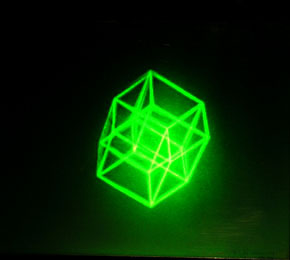
 |
HYPERCUBE 1989 8"x10" Provenance: |
|||
|
The simplest 2D figure is a square - in terms of orders of connectedness, it has 2 sides meeting at each corner. The simplest 3D polytope, a cube, has 3 edges meeting at each vertex, and can be represented in 2D by anaxonometric showing 6 squares joined in a way impossible in 2D.
A hypercube consists of 8 "cubic" cells with 4 meeting at each "facet"(?) folded into each other in 4D hyperspace in a way impossible in 3D, and can be represented in 3D by a wire sculpture of a cube within a cube joined at the corners, but in a way we can't make sense in terms of 3D geometry. The interesting thing is that by looking at stereograms of different views of a hypercube, it's possible to "see" an object that can't exist in the world our bodies and brains occupy. Also interestingly, artists can do this with less difficulty than mathematicians working in the field of multidimensional geometry. Even more interestingly, most of the population (including 4D mathematicians, but not artists) don't "see" in stereo - they use visual cues because that part of their brain is underdeveloped. I made the hologram so that even people with lazy stereo skills could "see" in 4D. It's a multiplex made from pin reg slides of computer-generated wireframes of 90, one-degree, views of a hypercube. I made them at Pratt Institute in Brooklyn, the only place where artists could access a computer powerful enough to model 4D geometry at that time - a VAX 2000, I think, running Pascal, probably beaten by a modern pocket calculator for memory. I became interested in multidimensional geometry because, along with chess problems, it was one of the very few interests that Duchamp had at the end of his life. Bob Connolly |
||||